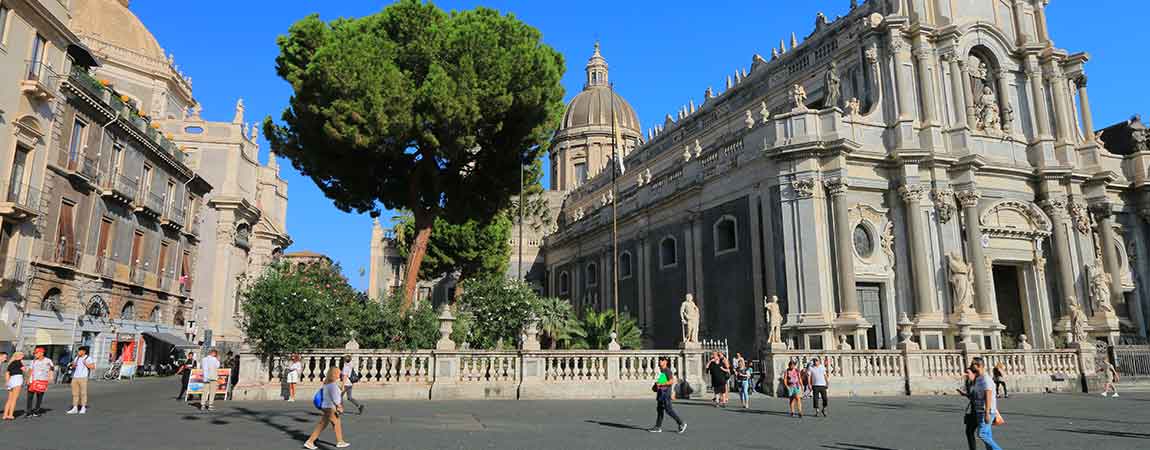
Catania is one of the most fascinating cities in Sicily and stands on the east coast of the island, in the shadow of Etna, the volcano that has wounded it several times without ever completely erasing it: after the eruption of 1669 the city has risen again establishing itself as one of the symbols of Sicilian Baroque, with a historic center declared a UNESCO World Heritage Site.
In addition to its historical and artistic heritage, Catania also fascinates visitors thanks to its legends and anecdotes concerning unsuspected places, from the U' Liotru Fountain to the beautiful Via dei Crociferi.
Curiosities about Catania: from the underground river to the story of Eliodoro
The beating heart of Catania is undoubtedly Piazza Duomo, overlooked by the splendid Cathedral of S.Agata , Abbey Church of S.Agata: at the center of this bright space stands the U'Liotru Fountain or the 'Elephant, with the sculpture of a stone pachyderm holding up a tall obelisk.
There are many legends that hover around this monument: it is said that it was built to keep the fairs away from the city during its foundation, becoming its symbol in 1239 in place of San Giorgio.
Another legend has it that this sculpture was the work of a certain Heliodorus, a young Christian who converted to black magic after meeting a sorcerer: it seems that the people of Catania rebelled against his dark power, so much so that Eliodoro took refuge inside the elephant itself, remaining imprisoned there for eternity.
At the edge of Piazza Duomo stands another very suggestive place in Catania, namely the Amenano Fountain: overlooks a small clearing where the picturesque takes place fish market, Piscaria, and leaning out from the same fountain you can see the namesake underground river flowing underneath of Catania. Not everyone knows that in the past the river was called Judge as it crossed the Jewish quarter of the city, it flowed on the surface but everything changed after the eruption of Etna in 1669. The lava flows literally buried the river, including the Lake of Nicitus that it fed: still today, however, the Amenano river, which takes its name from a half-man, half-bull Greek deity, emerges in some parts of Catania, including the Fountain near Piazza Duomo and the heart of the Youth Hostel.
The most famous curiosities and legends of Catania
One of the most enchanting places in Catania is the Via Crociferi, declared World Heritage Site by UNESCO: in just 200 m. they are present well four churches, i.e. the Jesuit College, the Church of San Francesco Borgia, the Church of San Giuliano and that of San Benedetto with the splendid Angel's Staircase.
A tetra legend affects this ancient road and concerns the headless horse.
It is said that in the 700th century this was a meeting place for clandestine lovers and noble conspirators, so much so that a headless horse roamed around in the middle of the night to keep prying eyes and ears away.
One day, a young man made the bet of going to Via Crociferi in the evening to drive a nail under the Arch of the Benedictine Nuns, as a test of his courage. So he did but after fixing the nail, at the sight of the infamous headless horse, he tried to escape but his cloak got caught in it. The animal ran over him and beheaded him and it is said that, on full moon nights, their ghosts still roam Via Crociferi.
They are also very fascinating legends relating to four lampposts in bronze present in University Square, in particular to that of the pious brothers and of Gammazita. The first tells of the young Anapia and Anfinomo, surprised by the eruption of Etna in 693 BC: the two brothers immediately thought of their elderly and paralytic parents, so much so that they immediately went home and loaded the two elderly men on their shoulders. The gods, moved with pity, helped the two young heroes by dividing the river of lava which threatened to overwhelm them.
The other legend instead it concerns the girl Gammazite who, during the Angevin domination of the thirteenth century, found herself persecuted by the increasingly explicit advances of the soldier Droetto. She never left the house again until the day she tried to reach the well in Via Calogero, a stone's throw from the Castle: here Droetto importuned her so heavily that Gammazita preferred to commit suicide by throwing herself into the well, rather than give in to the violence of the man .
Fly to Catania and immerse yourself in the beauty of this city, discovering corners of unexpected beauty cloaked in fascinating stories to learn and share.
© Image by Benjamin Smith, CC BY-SA 4.0, via Wikimedia Commons









